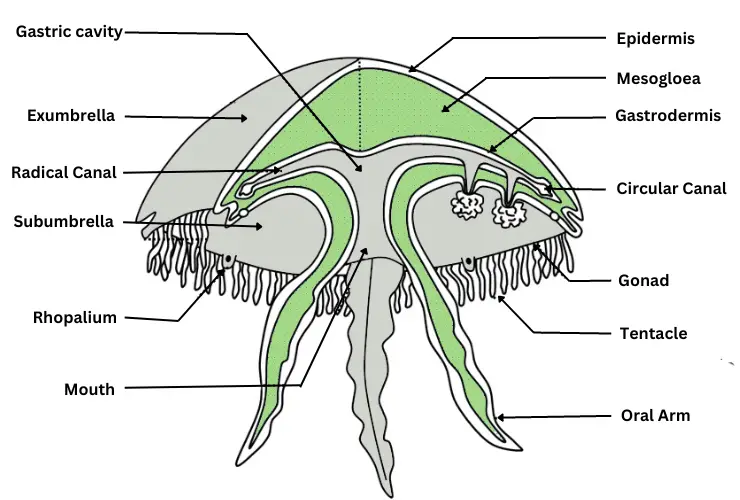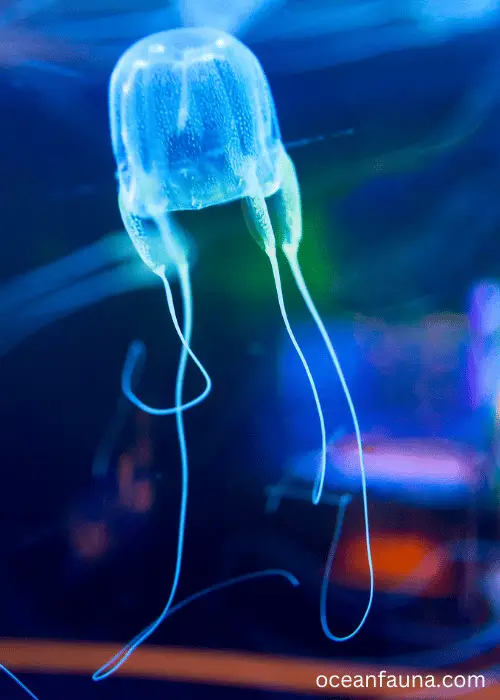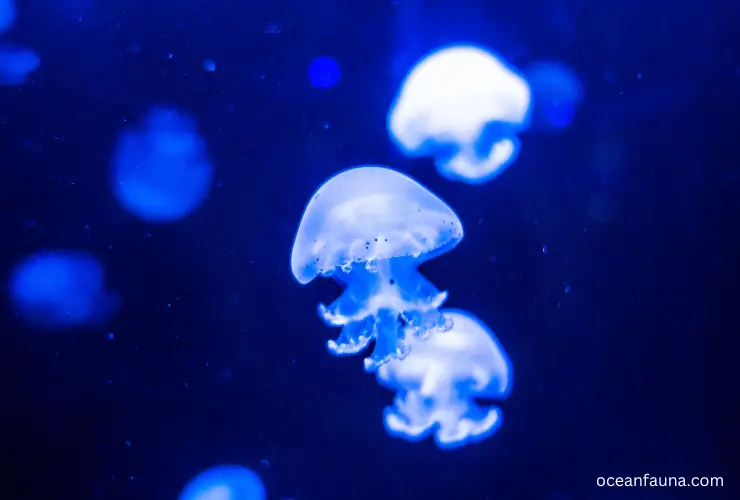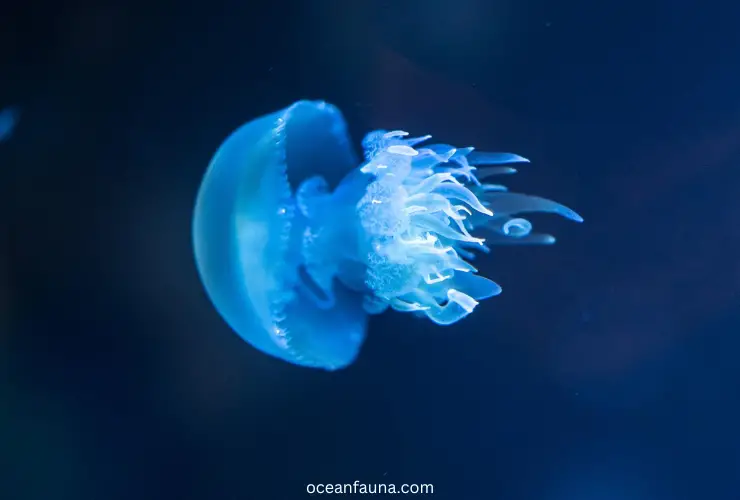No, jellyfish do not have teeth because they lack a skeleton system. However, Beroid Comb Jellyfish possess tiny finger-like projections or sticky cells that help them catch prey.
These projections are called Macrocillia and they help jellyfish to pierce, grind and direct their prey toward the gastrovascular cavity.
Jellyfish have been around for 600 million years. They have experienced ultimate evolution, enabling them to outlive all the mass extinction events of the Earth. They are considered to be one of the most primitive animals.
Hence, they only possess simple organs. Still, their basic anatomy gives them the strength to perform lethal predation.
Jellyfish are fascinating wonders of evolution. Let’s unveil more secrets about these mysterious creatures further in our article.
Species of Jellyfish That Thought to Have Teeth: Let’s Explore the Truth
Do all jellyfish have teeth? No, jellyfish do not have true teeth because their bodies do not have skeletons. Jellyfish belong to the primitive line of animals, and thus they have basic body structures.
However, only beroid Comb Jellyfish have teeth-like structures in the oral opening of their bodies. These tooth-like structures are known as Macrocillia.

These small projections allow this species of jellyfish to grab, shred, and move their prey toward their insides. This fascinating creature mainly feeds on small fish, shrimp, zooplankton, crustaceans, and small plants.
These are the primary prey of jellyfish. The stinging cells and Macrocillia of jellyfish help them become potent predators.
The Anatomy of Box Jellyfish: Do They Have Mouths or Teeth
Box jellyfish do not have teeth and mouths. They only possess a single opening for their digestive cavity. This opening is used for feeding as well as for excretion. Box jellyfish only feed on small fish and animals. Thus, they neither have nor require specialized teeth for eating.

The digestive cavity of this kind of jellyfish is divided into four different gastric chambers. The water flow and tentacles’ movement make the prey move inside these gastric pouches. The stinging cells and glandular cells inside the box jellyfish’s stomach help digest the food.
An Insight: Golden Jellyfish Have Teeth or Not
Do golden jellyfish have teeth? No, golden jellyfish do not have teeth. Golden jellyfish are soft-bodied cnidarians without a skeleton or bones in their bodies. Their bodies are adapted to catching prey and feeding without having teeth or tooth-like structures.
Golden jellyfish have a symbiotic relationship with algae named zooxanthellae. This organism provides this specific type of jellyfish with several required nutrients through its photosynthetic process. This is also another reason why golden jellyfish do not possess teeth.
The Number of Teeth and Polymorphism in Their Life Cycle
How many teeth do jellyfish have? As you already know, jellyfish are boneless and toothless creatures, so there is no question about how many teeth they have.

However, it is so called that Beroid Comb Jellyfish are the only species that possess teeth-like protrusions (mentioned earlier). These are not true teeth but hair-like projections that provide the function of teeth.
The species of jellyfish show polymorphism in their life cycles. This means that they exist in more than one different form. Jellyfish have two morphs: the medusa and the polyp.
The polyp forms have hair-like protrusions lining their mouths. These protrusions help in catching prey and feeding. Thus, these projections can be considered teeth.
Causes And Symptoms of a Jellyfish Bite
What happens if a jellyfish bites you? Jellyfish are primarily known for their stinging abilities. Commonly, the sting of most jellyfish only causes a burning and prickling sensation in the skin.
This burning will go away after a while. But the sting of some jellyfish can inflict extreme skin burning, convulsions, excruciating pain, and in some cases, death.
Causes
The tentacles of jellyfish contain thousands of stinging cells called nematocysts. These stinging cells are filled with venomous substances to paralyze prey.
Whenever something comes in contact with the tentacles or brushes against them, nematocysts get triggered. These cells immediately release venom to immobilize the prey.
Symptoms
The symptoms of a jellyfish sting can vary from minor to extreme. The type of jellyfish that stung you, how long ago you were stung, and where you were stung all affect how severe your symptoms will be. If not treated on time, severe symptoms can lead a person to death.
Minor Symptoms
- Swelling and redness
- Burning on the affected area
- Prickling sensation
- Severe itching
- Pain and shivering
Extreme Symptoms
- Excruciating pain
- Numbness
- Convulsions
- Nausea and vomiting
- Loss of consciousness
- Breathing issues
- Paralysis
Tips To Treat the Sting of a Jellyfish

What should you do if you get bitten by a jellyfish? You can treat the sting of a jellyfish by taking immediate action. Usually, jellyfish stings do not pose harmful effects and can be easily relieved. But if your symptoms persist and get severe, you should promptly visit the nearest doctor.
Following are the actions you can take if you get stung by a jellyfish:
- Thoroughly rinse off the affected area with hot water
- If you see a stinger on your skin, remove it immediately
- Apply the rubbing alcohol on the affected area to prevent the stinging from growing
- Put on any pain-relieving ointment to reduce the swelling and pain
- You can also take oral medication for pain relief
- Do not scratch and rub the affected area
- Never use human urine on a jellyfish sting
FAQs
Should I be worried if I got stung by a jellyfish?
No, there is nothing much to worry about a jellyfish stings. It is because most jellyfish stung can easily get cured by taking immediate medical steps.
Can box jellyfish hurt you?
Yes, the sting of the box jellyfish is venomous and can cause serious allergic reactions. If not treated carefully, the sting can also lead to other health issues.
What does a jellyfish bite look like?
Jellyfish can sting if you come in contact with their tentacles. The sting can cause burning, swelling, redness, and numbing in the affected area.
How long will a jellyfish sting last?
The species of jellyfish that stung you will determine how long it will take for the pain to subside. Usually, the sting lasts for two to three days. But the sting will take much longer to relieve in some severe cases.
Conclusion
Jellyfish are fascinating and enchanting creatures of the ocean. They come in various sizes, designs, shapes, and colors. The species of jellyfish are filled with charming variations. Although jellyfish have basic body structures and anatomy, they are efficient predators.
They also have specialized structures for stinging and paralyzing their prey. It is said that they can also sting a swimmer if he encounters their tentacles. This sting can be relieved after a while or by taking proper medical care. In the case of some lethal species of jellyfish, stings can cause serious issues.

